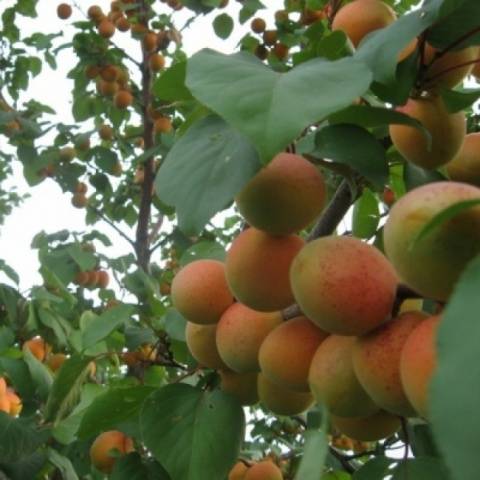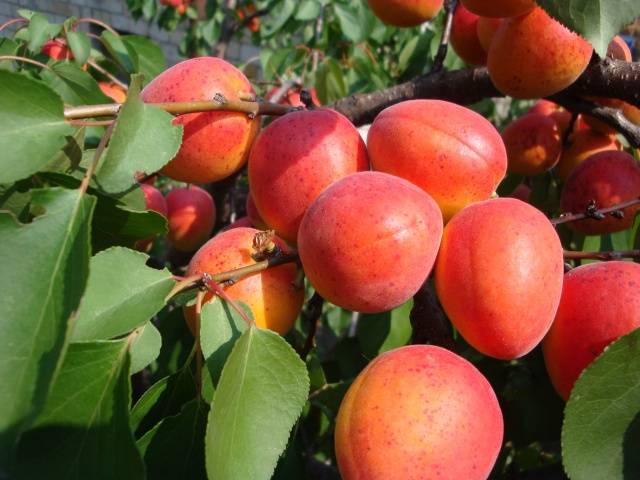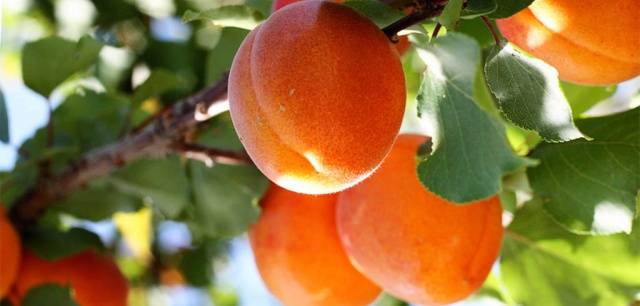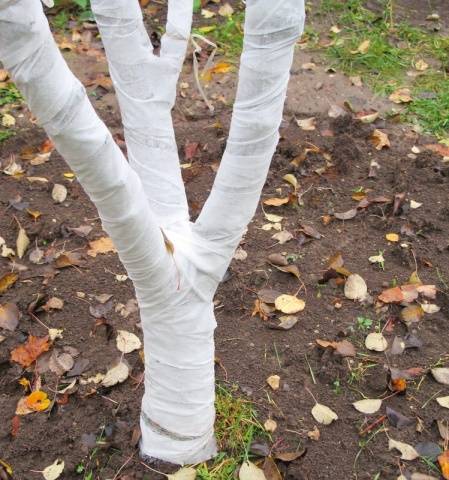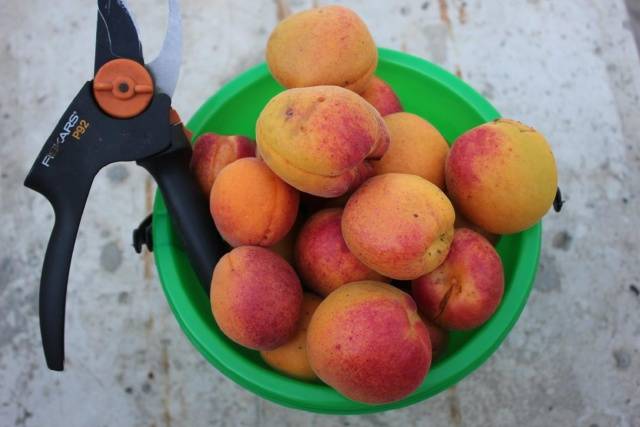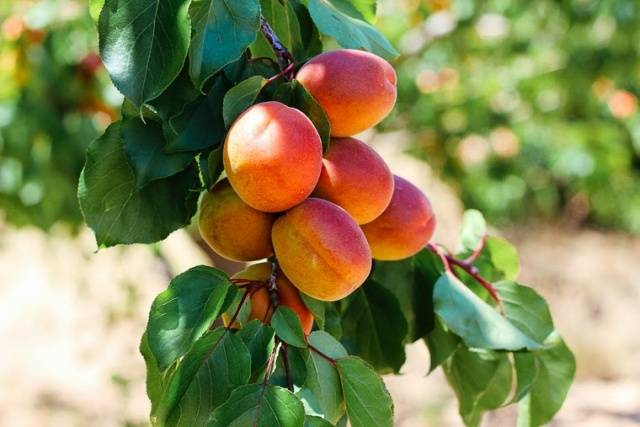Content
- 1 Breeding history
- 2 Description of culture
- 3 Characteristics
- 4 Landing features
- 5 Planting and caring for the Red-cheeked apricot in the Moscow region in the spring
- 6 How to grow a red-cheeked apricot in the Urals
- 7 Growing apricot Red-cheeked in the Middle Lane
- 8 Harvesting and processing
- 9 Diseases and pests, methods of control and prevention
- 10 Conclusion
- 11 Testimonials
Apricot Red-cheeked is one of the most common varieties growing in the southern part of Russia. It is appreciated for its good taste, early maturity and disease resistance.
Breeding history
The exact information about the origin of the variety has not been preserved. Specialists of the Nikitsky Botanical Garden, located in the Crimea, worked on it.
It is believed that the Krasnoshekiy variety was obtained by pollination of the wild form of apricot from Central Asia, which has reddish fruits. In 1947, tests were carried out, according to the results of which the variety was entered into the State Register.
Many hybrids were obtained on the basis of the Krasnoschekiy variety: apricot Son of Krasnoshchekiy, Cupid, Seraphim, Northern triumph, Khabarovsk.
Description of culture
Red-cheeked is a vigorous variety with a rounded spreading crown. The height of the tree reaches 4 m. The number of shoots is average, the crown is not prone to thickening. The tree has a lifespan of up to 50 years.
Characteristics of the Krasnoshekiy apricot variety:
- large sizes;
- average weight 50 g;
- rounded shape, compressed from the sides;
- narrow abdominal suture, deepening near the base;
- golden orange surface with reddish blush;
- the skin is thin and velvety, but quite dense;
- the pulp is dense, tender, light orange in color;
- average juiciness of fruits;
- good sweet and sour taste;
- a large bone that is easily separated from the pulp.
Photo of the apricot tree Krasnoshchekiy:
Apricot is recommended for growing in the forest-steppe and steppe zone. In Russia, the variety is grown in the North Caucasus (Dagestan, Ingushetia, Krasnodar, Rostov, Stavropol) and in the Lower Volga region (Kalmykia, Astrakhan).
Characteristics
When choosing in favor of the Krasnoschekiy variety, its winter hardiness, yield and self-fertility are taken into account.
Drought resistance, winter hardiness
The Red-cheeked variety is drought-resistant and is able to withstand a long absence of watering. The tree only needs moisture when it forms ovaries, so it is recommended to water it during flowering.
Frost resistance of apricot Red-cheeked is below average. When grown in the Middle Lane and colder regions, there is a high risk of tree freezing.
Pollination, flowering period and ripening times
The variety is highly self-fertile and does not require pollinator planting. The tree can become a pollinator for other varieties blooming at a similar time (Orlik Stavropol, Reklamny, Stavropol youth).
Due to its late flowering, the Red Cheeked Apricot does not suffer from spring frosts. The fruits ripen in medium terms. The crop is removed in the third decade of July.
Productivity, fruiting
Apricot brings its first harvest 3-4 years after planting. Up to 10 buckets of fruit are removed from one tree.
The yield of the Krasnoshchekiy variety is unstable. After a productive year, the tree needs rest.
Apricots are harvested in several stages. After ripening, the fruits do not stay on the branches for a long time and crumble.
Photo of apricot Red-cheeked:
Scope of the fruit
The fruits of the Krasnoshchekiy variety are of universal use. Due to their sweet taste, they are consumed fresh, and also used to prepare compote, juice, preserves, marshmallows, jam.
Disease and pest resistance
The Krasnoshchekiy variety is characterized by an average resistance to diseases and pests. The risk of fungal diseases increases in high humidity conditions. Rainy weather and fog can cause moniliosis.
Advantages and disadvantages
Advantages of planting Krasnoshchekiy apricot:
- early maturity;
- does not require a pollinator;
- high productivity;
- good fruit taste;
- not subject to spring cold snaps.
The main disadvantages of the variety:
- frost resistance is below average;
- dependence of yield on climatic conditions;
- susceptibility to disease when grown in lowlands.
Landing features
It is recommended to plant the apricot at a certain time. For planting, a pit is prepared and nutrients are introduced into the soil.
Recommended timing
In the southern latitudes, the culture is planted in the fall at the beginning of October. Before the onset of frost, the plant will have time to take root.
Spring planting of the Red Cheeked apricot is practiced in cold regions. Work is carried out after the snow melts, until the buds swell.
In the middle lane, both autumn and spring planting are performed. When choosing the timing, weather conditions are taken into account. If a cold snap is predicted earlier, then it is better to leave work until spring.
Choosing the right place
The place for growing Red-cheeked apricot is chosen taking into account a number of characteristics:
- location on a plain or elevation;
- light soil, good moisture permeability;
- lack of stagnant water;
- neutral or slightly alkaline soil reaction.
The culture prefers sunny areas. If the soil is acidic, lime must be added before planting.
What crops can and cannot be planted next to an apricot
Apricot does not tolerate the neighborhood of fruit and berry crops:
- raspberries;
- currants;
- apple trees;
- pears;
- hazel;
- plums;
- cherries.
Several varieties of apricots are planted in one area. The culture is removed from trees and shrubs by at least 4-5 m. Shade-tolerant grasses are planted under the tree.
Selection and preparation of planting material
It is better to buy seedlings of the Krasnoshchekiy variety in the nursery. For planting, choose annual plants with a developed root system. The tree is preliminarily inspected for damage and cracks.
Before planting, the roots of the seedling are placed in a mash made of water and clay. The consistency of liquid sour cream is optimal.
Landing algorithm
How to plant the Red Cheeked Apricot is indicated in the instructions:
- First, a hole is dug 60x60 cm in size and 70 cm deep.
- Fertile soil and compost are mixed in equal proportions, 400 g of superphosphate and 2 liters of wood ash are added.
- The resulting soil is poured into the pit.
- 3 weeks after the soil has shrunk, they begin to prepare the seedling.
- The plant is placed in a hole and the roots are covered with earth.
- The soil in the near-trunk circle is compacted and watered abundantly with water.
Follow-up care of the culture
Caring for Krasnoshchek apricot includes feeding and pruning. In the spring, trees are watered with infusion of mullein or chicken droppings. After flowering, phosphorus-potassium compounds are introduced into the soil.
Apricot pruning is carried out in the fall or spring. Dried and broken shoots are subject to elimination. Be sure to prune branches older than 3 years, since they bring a minimum yield.
To protect against freezing, the soil in the trunk circle is mulched with humus. The trunk of a tree is tied with a net or roofing material to protect it from rodents.
Planting and caring for the Red-cheeked apricot in the Moscow region in the spring
In the Moscow region, apricot is planted on the south side of a building or fence. This will give the wood more heat.
For planting, choose seedlings on the rootstock of cherry plum or plum. These plants have a stable root system. According to reviews about the Red-cheeked apricot in the Moscow region, the tree needs protection from freezing.
In the spring, trees are watered with preparations containing nitrogen. When the fruit ripens, potassium must be added, which affects the taste.
How to grow a red-cheeked apricot in the Urals
Planting and caring for Krasnoshchek apricot in the Urals have their own characteristics. Usually the taste of the Ural apricots differs from the fruits grown in the south.
The Urals are characterized by low temperatures in winter, spring frosts, sharp temperature fluctuations, and frequent precipitation. Increased attention is paid to protecting trees from fungal diseases.
So that the kidneys do not suffer from the spring cold snaps, the day before they are fumigated with smoke from burning straw. After the snow melts in the Urals, water remains in the soil for a long time. Therefore, before planting, a drainage layer of crushed stone is arranged at the bottom of the pit.
Growing apricot Red-cheeked in the Middle Lane
The Krasnoshchekiy variety is successfully grown in the Middle Lane. To obtain a high yield, it is important to choose the right place for planting, apply fertilizers and cut off the shoots.
The main problem of gardeners in the Middle Lane when growing apricots is spring frosts. To prevent the tree from freezing, special attention is paid to preparing for winter. The trunk is treated with lime and hilled, and the soil is mulched with humus.
Harvesting and processing
Harvest from a late variety of apricot Krasnoschekiy is harvested in dry weather in the morning from 10 to 11 o'clock. In the evening, fruit is removed after 17 hours. Fruits harvested in cold or hot weather lose their taste and aroma.
It is best to shoot unripe fruits. In this case, they ripen without problems in room conditions and are suitable for transportation.
Fruit is consumed fresh or processed. The fruits are canned or dried to obtain dried apricots.
Diseases and pests, methods of control and prevention
The most serious diseases of the culture are shown in the table:
Type of disease | Signs | Control measures | Prophylaxis |
Monilial burn | Flowers and shoots turn brown and dry. Cracks appear on the branches. | The affected parts are removed. Trees are sprayed with Bordeaux liquid. |
|
Fruit rot | Brown spots and gray bloom on the fruit. | Treatment of trees with Horus or Contifor preparations. |
The most dangerous crop pests are listed in the table:
Pest | Signs of defeat | Control measures | Prophylaxis |
Gallica | Larvae 2 mm long gnaw out the kidneys. | Removal of damaged kidneys. Spraying plantings with Kemifos. |
|
Aphid | The pest feeds on leaf juice, which leads to deformation of the shoots. | Spraying with Aktofit. |
Conclusion
Apricot Red-cheeked - a proven fruitful variety, resistant to diseases. The fruits are distinguished by good taste and a wide range of uses.
